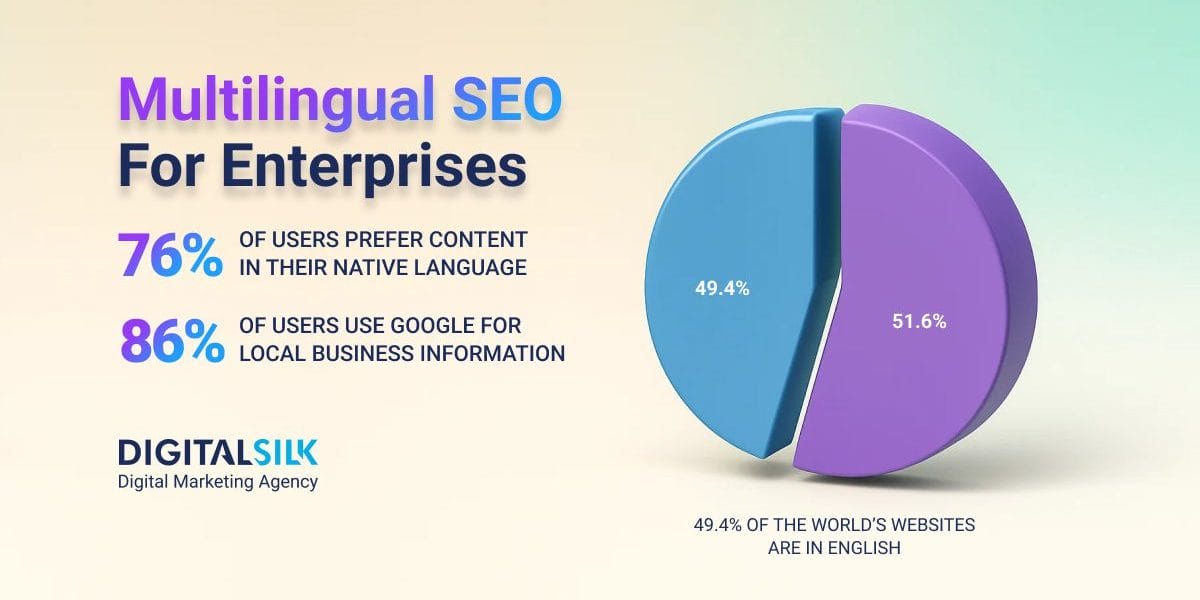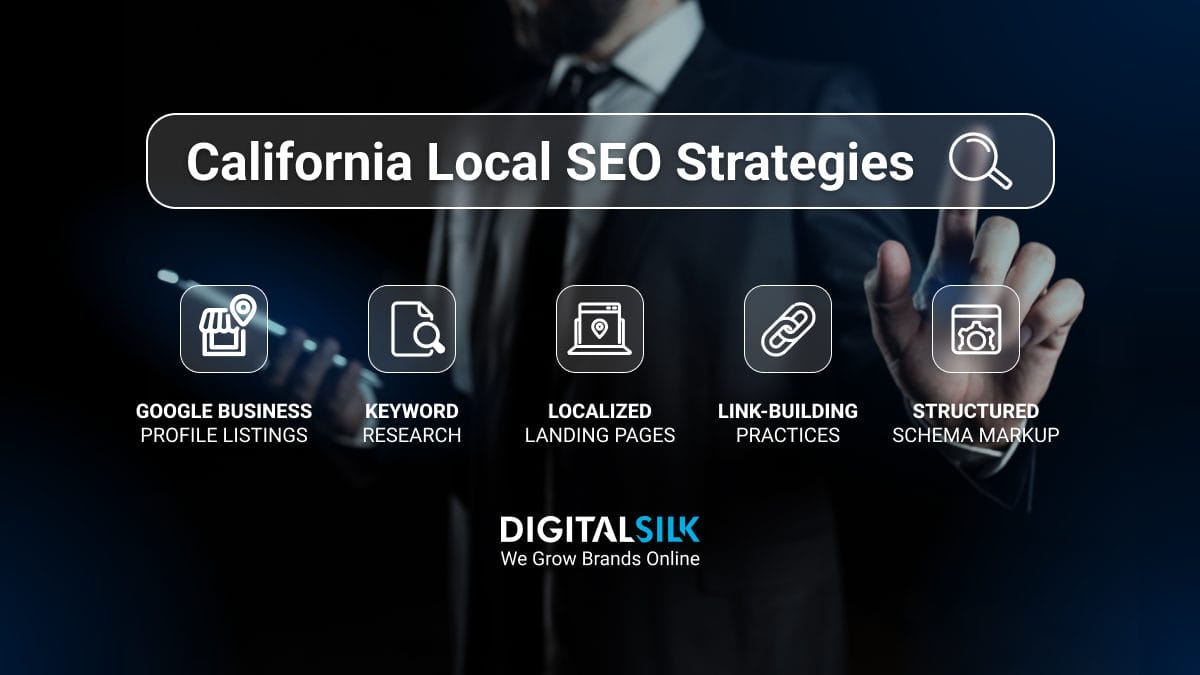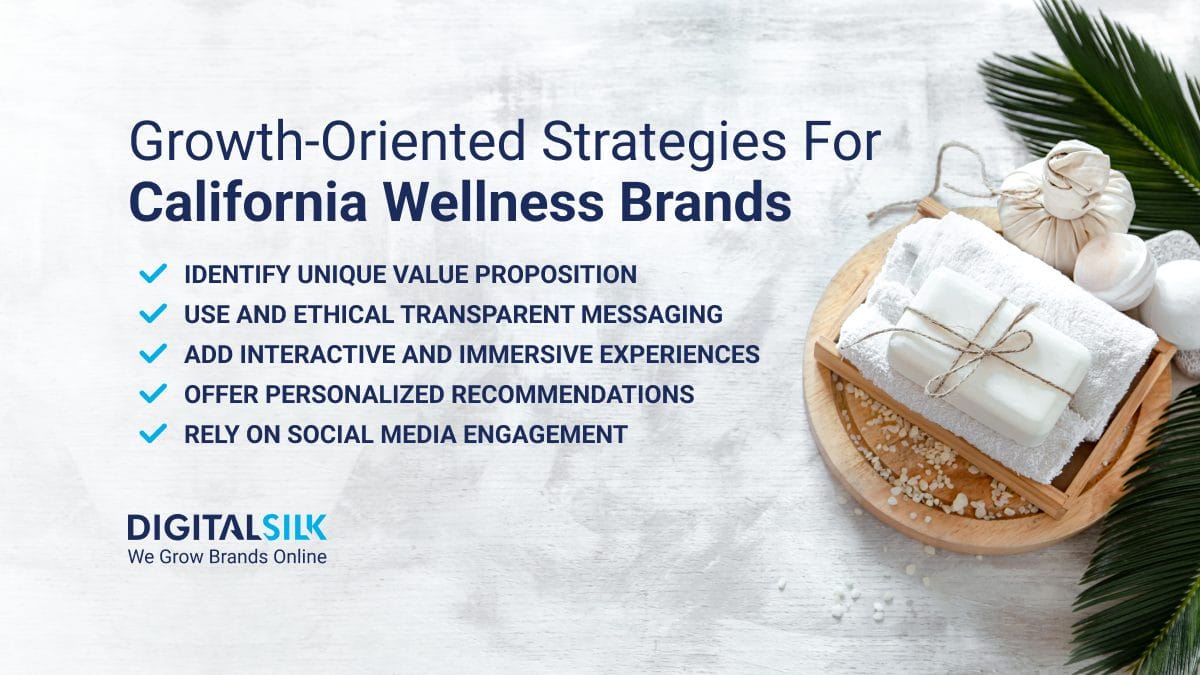Multilingual Guide: Key Highlights
-
Growth speaks many languages: Global visibility isn’t won by English alone. Fortune 500 brands build trust and clicks by speaking to each market in its own voice.
-
Translation isn’t strategy: Multilingual SEO at scale goes beyond technical fixes and aligns global objectives with local search habits to drive real market impact.
-
Systems scale success: Enterprise teams use data, precision and repeatable frameworks to turn multilingual search into a growth engine, not a one-time project.
When more than 49.4% of the world’s websites are in English, it’s tempting to think that global search visibility begins and ends with one language.
But Fortune 500 companies know that growth markets speak many tongues and simply translating your homepage won’t win their trust or their search clicks.
Multilingual SEO at this level is less about ticking technical boxes and more about creating a system where global strategy meets local nuances without losing momentum.
In this multilingual guide, we’ll explore how multilingual SEO for enterprises is done at scale, revealing the strategies behind global search, the practical challenges along the way and the business impact that follows.
12 Multilingual SEO Best Practices To Maximize Visibility
Organic search drives 53.3% of all website traffic and remains the strongest source of inbound growth.
Multilingual site SEO at scale runs on market data, operational precision and clear accountability, driving Return on Investment (ROI), shaping brand preference in key markets and strengthening long-term website performance.
The best practices in our multilingual guide below show how global teams structure their efforts to expand reach, improve search visibility and turn search into a repeatable growth channel.
1. Determine Target Markets
With 76% of online shoppers preferring product information in their native language and 40% unwilling to buy from sites in other languages, multilingual SEO starts by finding where language gaps block search-driven growth.
Tools like Google Analytics, SEMrush Market Explorer and Ahrefs Site Explorer help quantify search demand, local market share and revenue potential, giving you a clear view of where to focus first.
Build your market roadmap by aligning search opportunity, competitive gaps and operational capacity, so your efforts drive meaningful growth rather than stretch resources thin.
Prioritize markets where you can win and use revenue forecasts and competitor benchmarks to align your teams around what matters.
2. Consider Regional Search Engines And Listings
Google isn’t dominant in every market. In China, Baidu holds over 50% of the market share. In Russia, Yandex is still widely used.
Some users also discover businesses through local directories and industry-specific platforms.
For broader reach:
- Create country-specific strategies for non-Google engines (e.g., Baidu Webmaster Tools, Yandex Metrica)
- Register on local directories, including government portals, marketplaces and forums
- Optimize for local map and business listing platforms when relevant
This ensures discoverability where your customers search, even when it’s not on Google.
3. Target Local Keywords
The words people use to search for your products change from one country to another, even when the language stays the same.
Customers in the U.S. search for “apartments” while people in the UK search for “flats” and this type of variation shapes what shows up in search results.
Start by identifying seed keywords in the local language with help from native speakers or qualified translators who understand how your customers speak, not how automated tools translate.
Expand your list using SEMrush’s Keyword Magic Tool or Ahrefs’ Keyword Explorer to measure search volume, competition and intent for each region.
Since 80% of people use Google to find local business information, this step shapes whether your products show up when it matters most.
Build your keyword strategy for each region using real-world search behavior and apply those terms across your website copy, metadata and technical SEO.
4. Optimize Your URL Structure
84% of businesses report revenue growth from localization efforts, with 52% identifying website optimization as their most impactful channel.
One of the first decisions that shapes your global SEO strategy is how to structure your URLs.
This determines how clearly search engines index your pages, how users recognize your local presence and how efficiently your teams can scale technical operations.
Separate domains (ccTLDs) are widely used by large brands because they create an immediate sense of local trust.
This approach clearly signals the target country but requires building and managing SEO authority for each domain individually, which can be resource-heavy and operationally complex.
This is how you can include separate domains in your multilingual SEO strategy:
- www.example.es
- www.example.fr
- www.example.de
For instance, Amazon, ranked second on the Fortune 500, takes a country-specific approach to multilingual SEO by operating separate domains for each market.
This way, the brand builds strong local trust and optimize each site for market-specific search behavior, regulatory requirements and customer pain points.
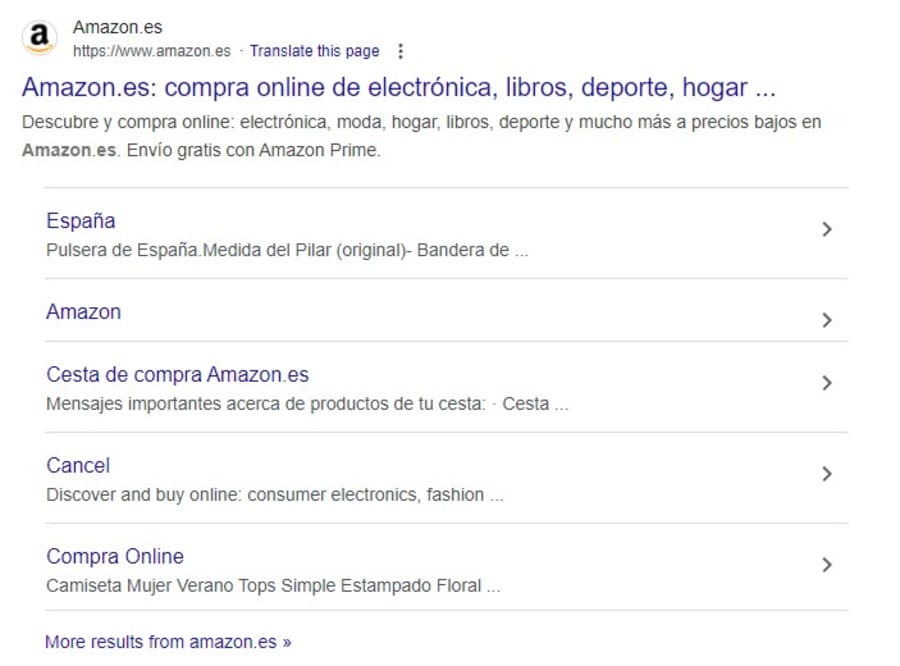
Another option is to use subdomains, creating dedicated sections of your main domain for each market.
This approach allows localized hosting and flexible technical setups but splits SEO authority across different parts of your site, often requiring extra effort to build visibility.
Some URL structures you can implement with this strategy include:
- es.example.com
- fr.example.com
- de.example.com
A third approach is to use subfolders, which keep all markets under a single domain.
This simplifies SEO management, consolidates authority and streamlines reporting, though it may feel less familiar to some users in markets where local domains carry more trust.
The signature URL structure with this approach is:
- example.com/es
- example.com/fr
- example.com/de
Avoid using parameterized URLs, as these are not recommended by Google for multilingual or multi-regional sites.
Examples of poor URL structures include:
- example.com?lang=es
- example.com?lang=fr
- example.com?lang=de
Google’s crawlers struggle to correctly interpret language and region targeting in these formats, often indexing the wrong version of a page or missing it entirely.
These URLs also create a poor user experience, since the links are harder to understand, share and bookmark.
5. Translate And Optimize Page Content
28.6% of users rely on translation tools every week, meaning brands that fail to publish accurate, localized content give away control of their search experience to third-party platforms.
Google Translate might give you a starting point, but it misses the tone, phrasing and search intent that drive performance in local markets.
Collaborating with a specialized multilingual SEO consultancy agency gives enterprises the market intelligence and executional expertise needed to craft truly localized SEO campaigns.
This should cover your on-page text, relevant currencies, measurements, date formats and error messages that shape the full customer journey.
Optimize every key SEO element in the local language:
- Title tags under 60 characters, aligned with how local users search
- Meta descriptions under 120 characters, written for clarity and clicks rather than keyword stuffing
- URL slugs that are short, meaningful and language-specific, using hyphens instead of underscores
- Internal links that keep users within the same language section of your site, improving navigation and helping Google map the content structure
- Image alt text translated to reflect what local users might search for visually
Beyond the page, build multilingual backlinks from sites that operate in your target markets and industries.
Don’t waste effort chasing links from irrelevant sites. Instead, prioritize local publishers, industry blogs and directories that speak to your audience and build long-term SEO value.
This isn’t a copy-paste translation project. It’s a market-by-market rebuild of your search visibility and brand relevance.
For example, Apple, ranked fourth on the Fortune 500 list, adapts its meta titles and descriptions to reflect local search behavior and consumer expectations in each market.
In France, the meta title clearly presents the brand and key product categories in French, helping users quickly understand what the site offers.

The meta description focuses on what drives action in the market such as new product launches, seamless shopping and fast delivery, all written in a tone that resonates with local consumers and local search patterns.
6. Adapt Content To Local Culture And Context
Effective localization considers nwo just the words, but also tone, cultural values and market-specific behaviors.
To create culturally relevant content:
- Adapt tone (formal/informal), storytelling, visuals and humor to local norms
- Use region-specific examples, idioms, and case studies
- Avoid direct translations of call-to-action buttons and test what resonates in each region
- You may also need to tailor visual layouts, such as RTL (right-to-left) support for Arabic or character spacing for Chinese and Japanese markets.
This approach enhances emotional connection, trust and engagement at the local level.
7. Implement Proper Hreflang
Your hreflang implementation should be part of a broader multilingual seo strategy, ensuring that users and search engines alike access the right localized content effortlessly.
Google uses over 200 ranking factors to decide which page to show to a user and hreflang is one of the clearest ways to control which version of your content appears in search.
Without it, the search engine may classify localized pages as duplicates or show the wrong language version in key markets.
Hreflang tags define which language and region each version of a page serves, helping your content reach the intended audience without competing against itself.
There are three ways to implement this: HTML header tags, XML sitemaps and HTTP headers.
Each method works, but your teams should select the one that fits your infrastructure and content management workflows.
Example in the HTML header for a German-language page:
- <link rel=”alternate” hreflang=”de” href=”https://yourwebsite.com/de/” />
Example in an XML sitemap:
- <xhtml:link rel=”alternate” hreflang=”de” href=”https://yourwebsite.com/de/” />
For market-specific targeting, use both the ISO 639-1 language code and the ISO 3166-1 Alpha-2 region code.
If your German-language content serves both Germany and Austria, your hreflang tags should include:
- <link rel=”alternate” hreflang=”de-de” href=”https://yourwebsite.com/de-de/” />
- <link rel=”alternate” hreflang=”de-at” href=”https://yourwebsite.com/de-at/” />
Always use full URLs, including the protocol (https). Every version of a page must list itself and all its alternates, creating a complete set of bidirectional links. Without this, Google may ignore your hreflang signals.
Here’s an example of an XML sitemap for three pages: an English-language page for global audiences, a German-language page for Germany and a German-language page for Switzerland.
Each entry lists itself and the other versions, allowing Google to understand they are regional variations of the same content:

Include an x-default tag for users whose language or region does not match a specific version:
- <link rel=”alternate” hreflang=”x-default” href=”https://yourwebsite.com/” />
Google Search returns the appropriate result for the user according to their browser settings.
When targeting the same language across multiple regions, include both the regional pages and a fallback page.
For example:
- en-us for the United States
- en-gb for the United Kingdom
- en for other English-speaking users
Microsoft, ranked among the top companies in the Fortune 500, uses region-specific hreflang tags to direct users to the right version of its site.
For example, the United Kingdom version of its content is tagged with en-gb, helping Google serve UK users pages that reflect local spelling, terminology and offers.
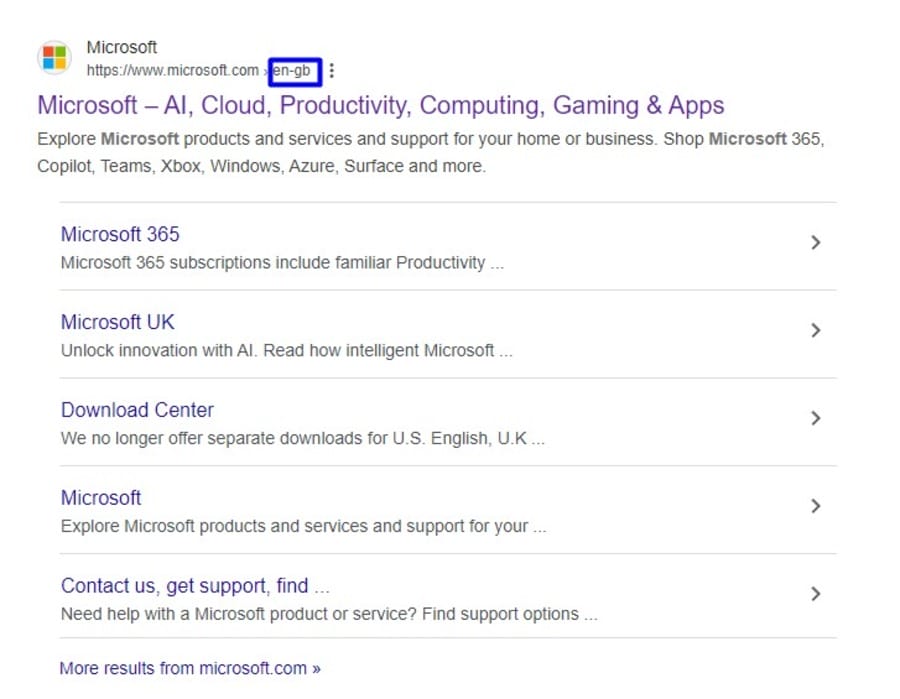
Hreflang doesn’t determine the language of the page itself, since Google’s algorithms detect the content language automatically.
What hreflang controls is which user in which region sees which version, helping you protect your search performance in every market and avoid internal competition between your pages.
To implement hreflang correctly at scale, follow these steps:
- Choose the best method for your systems and operational capacity
- Format the tags correctly with hreflang attributes and fully qualified URLs
- Test your tags regularly using Google Search Console‘s International Targeting report or hreflang testing tools
- Keep your sitemap or header tags updated as you expand into new markets or restructure your URLs
8. Don’t Redirect Users Based On IP Address Or Cookies
Redirecting visitors based on their IP address or cookies often creates more problems than it solves.
Instead of forcing users onto a regional version of your site, give them a prompt or clear navigation to switch languages or regions on their own terms.
For example, Dell Technologies offers both a language selector and a country selector in its top navigation menu, giving users clear control over which market version they want to visit.
In addition, a pop-up prompt asks whether users want to switch to their local country site or continue browsing the current version, allowing them to choose the experience that fits their needs.
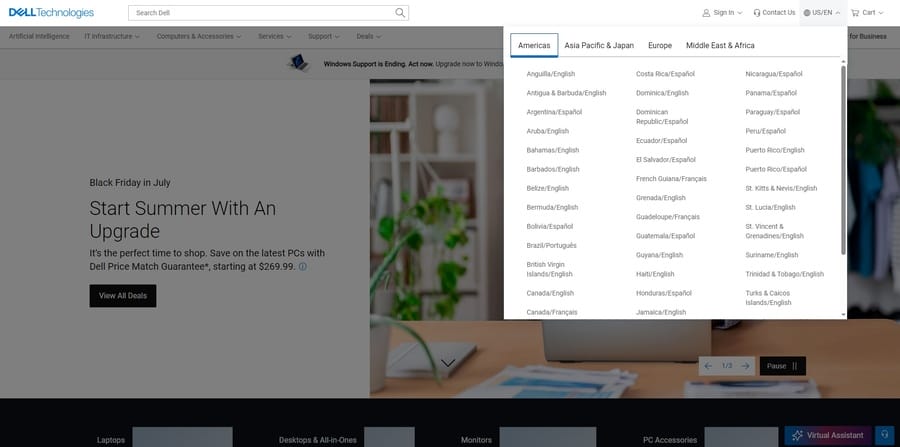
This approach respects user choice and avoids blocking Google from crawling your localized content.
Most of Google’s crawlers operate from U.S.-based IP addresses, so automatic redirects often send them to your U.S. pages, leaving other markets under-indexed.
Creating exceptions for Googlebot is risky and defeats the purpose of giving search engines the same experience as users.
Google advises against using IP-based redirects, stating that IP analysis is unreliable and often prevents search engines from properly indexing localized versions of your site.
A better approach is to let the user select their region and language through your site’s navigation, keeping both the user journey and search visibility intact.
When you work with a seasoned multilingual SEO consultant, you gain access to advanced technical solutions and strategic insights for seamless international SEO execution.
9. Create Localized Content
Content strategy drives impact across every market and accounts for 16.7% of leading SEO strategies worldwide.
In international SEO, this means publishing content that speaks to local business priorities, industry conversations and cultural context.
High-performing teams build articles, resources and campaigns shaped by market trends and in-region expertise, giving their content long-term relevance and visibility.
Agencies that provide white label multilingual SEO allow partners to deliver comprehensive SEO solutions without the need to build in-house multilingual capabilities.
For example, Nvidia’s German site publishes articles focused on AI innovation, regional partnerships and industry events that matter to German-speaking audiences
Recent content highlights topics like industrial cloud solutions with Deutsche Telekom, advances in automotive AI and local training programs for 3D development.

10. Monitor Site Performance And Health
Measuring how your multilingual pages perform is as important as creating them.
20% of SEO professionals monitor keyword rankings first, followed by organic page views, but those metrics only tell part of the story.
Technical performance, especially speed and stability, plays a direct role in how well your pages rank and convert across markets.
A global multilingual SEO approach brings together localized content, technical excellence, and international visibility under one strategy.
Google uses Core Web Vitals to measure user experience, including load speed, interactivity and visual stability.
Slow-loading pages are more likely to lose engagement, with one second delays resulting in 11% fewer page views.
Track the Core Web Vitals that shape both search performance and customer experience:
- First Contentful Paint (FCP): How quickly the first visible element appears, giving users confidence that the page is loading.
- First Input Delay (FID): How fast the site responds when a user clicks or taps, reflecting real-world interactivity.
- Largest Contentful Paint (LCP): How long it takes for the main content to load fully and become usable.
- Cumulative Layout Shift (CLS): How stable the page layout remains while loading, preventing unexpected shifts in text or images.
Monitoring these metrics helps you identify where technical gaps slow down user engagement or weaken your search visibility in local markets.
Performance audits should be a continuous part of your enterprise SEO solutions, giving your teams the insight to keep site speed, usability and search performance aligned as your multilingual footprint grows.
11. Integrate Global Dashboards And Automation Tools
Enterprise teams managing multilingual SEO need centralized visibility and automation to scale effectively.
This is a growing trend, with 75% of businesses using at least one form of marketing automation to streamline their efforts.
Tools like SEMrush, Conductor, BrightEdge and Looker Studio can:
- Unify data by region, language and page type
- Track local rankings, Core Web Vitals, backlinks and conversions
- Identify performance gaps per market
- Automate alerts for indexation issues or ranking drops
Incorporating multilingual dashboards allows you to pivot quickly across teams and markets while maintaining SEO momentum.
12. Prepare For Voice And AI Search
Voice search is changing how people discover information, especially in mobile-first and emerging markets.
90% of consumers say that the voice function makes it easier to search for something online.
Multilingual SEO at scale must now account for how AI systems like Google SGE, ChatGPT, and Siri source and display results across languages.
To optimize for voice and AI search:
- Use conversational keyword phrases: Think “how do I apply for a visa in Spain?” vs. “visa Spain application”
- Structure content using FAQ formats, which voice assistants often pull from
- Implement schema markup (FAQPage, HowTo, Product) to increase eligibility for featured snippets and AI summaries
- Ensure page load speed and mobile usability, as voice and AI devices prioritize quick-to-serve content
Voice-first readiness future-proofs your site in regions where smartphones are the dominant internet access point.
The Benefits Of Multilingual SEO For Enterprises
Multilingual SEO is more than a technical adjustment. It is a long-term driver of market expansion, customer trust and measurable growth.
When you implement our multilingual guide, it becomes a repeatable system for reaching new markets, improving customer experience and building competitive advantage across regions.
1. Expanded Global Reach
Multilingual SEO helps your business reach audiences that would otherwise never find you in search results.
Instead of competing only in your home market, you open doors in regions where customers search in their native language.
In fact, 59% of businesses report that SEO has driven higher return on investment, showing that global search visibility translates directly into business results.
Enterprise teams who prioritize language-specific SEO expand their pipeline and build brand familiarity where few competitors are visible.
2. Improved User Experience For International Audiences
People prefer to engage with brands that speak their language and reflect their cultural norms.
Localizing your website experience, from product descriptions to help articles and support content, removes friction and builds trust.
This attention to market nuance strengthens customer relationships and increases loyalty over time, especially in regions where few global brands take the time to localize properly.
3. Increased Organic Traffic From International Searches
Optimizing for multiple languages helps your pages show up in local search results, capturing demand from new regions without needing constant paid campaigns.
Organic traffic expands market by market, creating a scalable source of inbound growth that is less sensitive to ad budgets and seasonal fluctuations.
Over time, this builds a broader, more resilient search footprint across regions and languages.
By applying SEO multilingual techniques, your website gains visibility across multiple markets and search engines.
4. Higher Conversion Rates In Local Markets
Localized content performs better because it reflects how people actually think and buy in a market.
Any multilingual SEO expert would ensure that your content and technical setup align with local search expectations, driving visibility and engagement in every target market.
When customers see content written in their language, shaped by their needs, they respond with higher engagement and stronger intent.
This is where multilingual SEO becomes a growth engine, turning local search traffic into pipeline, revenue and market share.
5. Competitive Advantage In Underserved Markets
Many global companies still prioritize English-only SEO, leaving wide gaps in regional search results.
By investing in multilingual SEO, you claim visibility in markets where competitors are slow to adapt.
This allows you to build search authority and brand awareness where others are absent, giving your teams a measurable head start in growing regions.
Partnering with multilingual SEO experts accelerates your ability to capture and maintain search leadership in global markets.
Common Challenges When Executing SEO Strategies
Even well-planned SEO strategies run into obstacles during execution, especially when multiple teams and markets are involved.
These challenges can slow down growth, create operational bottlenecks or limit how fast you adapt to shifting search trends.
Here are five of the most common barriers global teams face:
- Changing Google algorithms: 22.2% of SEO professionals identify this as their biggest challenge, since search updates often disrupt performance across markets without warning.
- Maintaining technical SEO across markets: As multilingual sites expand, it becomes harder to apply consistent technical SEO standards across platforms, teams and regions.
- Local content quality and relevance: Many companies struggle to produce content that feels native to each market, instead of reading like a direct translation of global messaging.
- Tracking and reporting across regions: Disconnected tools and inconsistent key performance indicators (KPIs) make it difficult to track search performance and ROI from a single, unified viewpoint.
- Slow page speed in some regions: Pages often perform well in core markets but load slowly in others, due to infrastructure gaps or under-optimized hosting environments.
Optimize Your Multilingual SEO With Digital Silk
Multilingual SEO creates long-term growth when strategy, content and technical performance align across markets.
Building this foundation takes clear priorities, consistent execution and regular performance tracking to stay visible where it matters.
Digital Silk monitors the performance of your website across search, technical health and localized content quality to help your enterprise expand global reach through multilingual SEO.
As a recognized digital marketing agency, our services include:
- SEO services
- Digital marketing
- Social media marketing
- eCommerce PPC
- Custom web design
- Branding services
Want to build search strategies that drive growth in every market you enter?
Contact our team, call us at (800) 206-9413 or fill in the Request a Quote form below to schedule a consultation.
"*" indicates required fields


